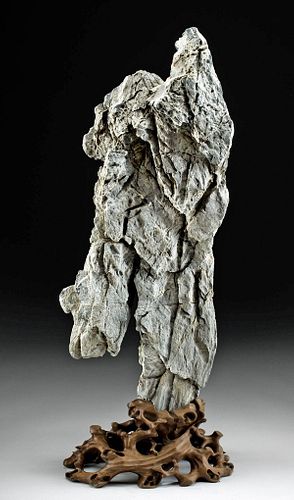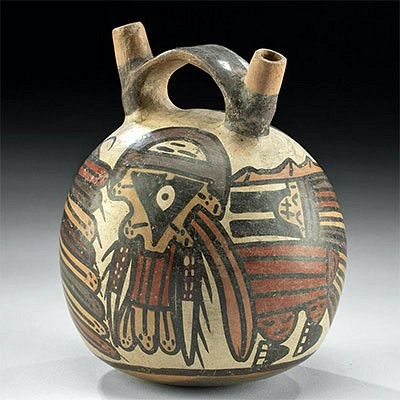17th C. Chinese Ming Dynasty Scholar's Stone
Lot 51
About Seller
Artemis Gallery
686 S Taylor Ave, Ste 106
Louisville, CO 80027
United States
Selling antiquities, ancient and ethnographic art online since 1993, Artemis Gallery specializes in Classical Antiquities (Egyptian, Greek, Roman, Near Eastern), Asian, Pre-Columbian, African / Tribal / Oceanographic art. Our extensive inventory includes pottery, stone, metal, wood, glass and textil...Read more
Categories
Estimate:
$2,400 - $3,600
Absentee vs Live bid
Two ways to bid:
- Leave a max absentee bid and the platform will bid on your behalf up to your maximum bid during the live auction.
- Bid live during the auction and your bids will be submitted real-time to the auctioneer.
Bid Increments
| Price | Bid Increment |
|---|---|
| $0 | $25 |
| $300 | $50 |
| $1,000 | $100 |
| $2,000 | $250 |
| $5,000 | $500 |
| $10,000 | $1,000 |
| $20,000 | $2,500 |
| $50,000 | $5,000 |
| $100,000 | $10,000 |
| $200,000 | $20,000 |
About Auction
By Artemis Gallery
Feb 10, 2022
Set Reminder
2022-02-10 10:00:00
2022-02-10 10:00:00
America/New_York
Bidsquare
Bidsquare : Ancient & Ethnographic Art Through The Ages
https://www.bidsquare.com/auctions/artemis-gallery/ancient-ethnographic-art-through-the-ages-8873
Join us for Part Two of a spotlight on two fabulous collections, one from Lumberton, Texas, and the other from Whisnant Gallery in New Orleans. Artemis Gallery info@artemisgallery.com
Join us for Part Two of a spotlight on two fabulous collections, one from Lumberton, Texas, and the other from Whisnant Gallery in New Orleans. Artemis Gallery info@artemisgallery.com
- Lot Description
East Asia, China, late Ming to early Qing Dynasty, ca. 17th to 19th century CE. A fine "gongshi" also known as a scholar's rock or stone, this example is a naturally formed piece of gray limestone that stands upright on a wooden base with a naturally craggy and chiseled profile. This weathered and eroded form suggests that this rock was collected and displayed because of its striking appearance - naturally shaped by water to create the unique craigs and crevices. It is accompanied by a low, dark cherry-colored wood base of twisting and sinuous gnarled shape. The term "scholar's stone" is traditionally used to describe rocks of a distinctive shape, color, and texture, with an appearance impressive enough to be deemed fitting for meditation in a scholar's studio or to display in a garden. Stones such as this were prized for their resemblance to mountains, landscapes, texture, and resonance tone when tapped. Note the petite seashells and marine encrustations tucked into some of the crags and crevices! Size: 12" W x 28.3" H (30.5 cm x 71.9 cm); 33" H (83.8 cm) on included custom stand.
Gongshi are part of the Chinese tradition of venerating beautiful stones which extends back to the Neolithic, when prized geological specimens were placed into tombs as offerings. In the Song Dynasty, Chinese writers composed essays and catalogues dedicated to rocks; artists began to paint them in elegant compositions that celebrated their natural qualities as evocative of larger forms in the landscape like prominent mountains or mythological creatures like dragons. A Chinese scholar would have displayed this example in his studio so that he and other members of the literati could contemplate its contours, perhaps serving the same function as Italian Renaissance studiolo paintings - an object of outward gaze that facilitates inward reflection and contemplation, an aesthetic exercise of the intellect. Being an object from the earth rather than a manmade painting, gongshi allow for a more natural lens through which one can ponder the inherent relationship of man, nature, and the cosmos.
Provenance: private Hawaii, USA collection; ex-M. Kobiashi collection, Hawaii, USA, 1960 to 2000
All items legal to buy/sell under U.S. Statute covering cultural patrimony Code 2600, CHAPTER 14, and are guaranteed to be as described or your money back.
A Certificate of Authenticity will accompany all winning bids.
PLEASE NOTE: Due to recent increases of shipments being seized by Australian & German customs (even for items with pre-UNESCO provenance), we will no longer ship most antiquities and ancient Chinese art to Australia & Germany. For categories of items that are acceptable to ship to Australia or Germany, please contact us directly or work with your local customs brokerage firm.
Display stands not described as included/custom in the item description are for photography purposes only and will not be included with the item upon shipping.
#168907Natural weathering of stone. Intact and excellent with nice encrustations.Condition
- Shipping Info
-
All shipping is handled in-house for your convenience. Your invoice from Artemis Gallery will include shipping calculation instructions. If in doubt, please inquire BEFORE bidding for estimated shipping costs for individual items.
-
- Buyer's Premium



 EUR
EUR CAD
CAD AUD
AUD GBP
GBP MXN
MXN HKD
HKD CNY
CNY MYR
MYR SEK
SEK SGD
SGD CHF
CHF THB
THB














